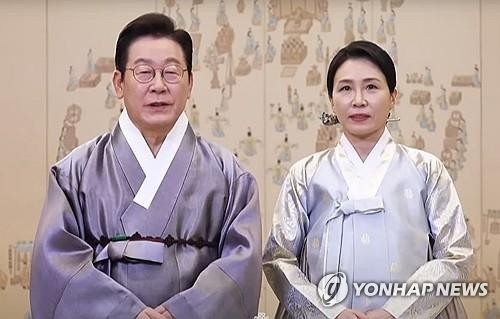The episode was framed as a cultural promotion of K‑food (Korean cuisine) and food culture.
However, the timing—coming right after a major fire at a government data center—triggered a sharp public backlash.
Supporters and critics raced to spread competing narratives, and the controversy quickly turned political.
Is the first couple’s TV appearance outreach or negligence?
Start with the timeline.
At the end of September 2025, a large fire at a national data‑center agency disrupted government computer systems for days.
The blaze resulted in the tragic death of an official and required prolonged recovery work.
About 18 hours after the incident, President Lee and the First Lady took part in a Chuseok special recording of JTBC’s “Please Take Care of My Refrigerator” (a popular cooking variety show where celebrity chefs cook from a guest’s fridge).
The episode aired on October 6 and was presented as a soft‑power program promoting K‑food to international audiences.
These consecutive events immediately became a political flashpoint.
News coverage and social posts split into heated pro and con camps.
This section focuses on the objective sequence of events and the basic facts.
However, facts lead quickly into interpretation, and that is where disagreement began.

The image of the first couple on a lighthearted show deepened the divide.
Some praised the move as a positive cultural‑diplomacy step that boosts national image.
On the other hand, many criticized the timing as insensitive amid a national emergency.
The debate soon moved beyond a single broadcast to questions about institutional norms and public ethics.
Arguments in favor
The power of popular communication.
First, proponents stress the value of promoting K‑food and national image.
Having the president introduce Korean ingredients and dishes can be a traditional soft‑power tool that helps tourism, exports, and the country brand in an era of intense cultural competition.
Seen this way, the television appearance was a strategic move in diplomatic and economic terms.
Second, they argue that public duties and media outreach can run in parallel.
The presidential office said the president received continuous briefings about the fire and continued to make decisions and issue instructions while participating in other activities.
Therefore, being away from a specific physical location does not automatically equal shirking responsibility.
In modern presidencies, leaders often juggle multiple channels at once, and official appearances aimed at national interest can be scheduled flexibly.
Third, there is an argument about the popularization of governance.
In contemporary democracies, a leader’s humanized image can build trust with citizens.
Television variety shows reduce psychological distance between officials and the public.
Thus, seeing the president and first lady in a relaxed, relatable setting might restore or broaden public confidence.
This view emphasizes a practical mix of image management and cultural diplomacy rather than mere entertainment.
Supporters say this is not just fan service.
They frame the episode as a calculated initiative with cultural, economic, and diplomatic aims.
However, whether that calculation pays off depends on how well public responsibility and popular outreach are balanced with public sentiment.
Arguments against
Timing is the core issue.
In a crisis, priority responsibilities are expected of leaders.
Critics first highlight urgency and respect for victims.
Given that the data‑center fire crippled government systems and cost a life, the choice of public schedule goes straight to public emotion.
From this angle, crisis response and mourning should trump cultural promotion; appearing on a variety show during that window looks tone‑deaf.
Second, opponents warn of morale damage among civil servants and responders.
Those working long hours to restore services take cues from top leadership.
If frontline workers sense a mismatch—if they view the program as a political spectacle—their morale and trust in leadership may fall sharply.
This isn’t just image warfare; it affects operational efficiency and institutional cohesion.
Third, questions about transparency and online moderation have deepened distrust.
Allegations that critical comments were removed from the show’s YouTube posts raised concerns about manipulation of public opinion.
If such moderation is proven to be coordinated, it would threaten media fairness and the integrity of democratic discourse.
Consequently, critics call for legal reviews and political accountability to clarify what happened.
In short, the opposing view stresses ethics and institutional priority.
Public officials are held to a stricter standard during national emergencies, and that expectation reflects a broader commitment to respect for victims and social solidarity.
Untangling the clash
The two positions can be complementary rather than mutually exclusive.
It is not simply a question of right or wrong.
The promotional impact supporters describe is real and could contribute to the nation’s brand over time.
Meanwhile, the immediacy critics emphasize cannot be dismissed when it comes to public trust and shared mourning.
So the dispute boils down to competing priorities: what should be put first in the eyes of the public?
The key issue is how to calibrate policy, image, and ethics.
This debate naturally points to institutional fixes.
For example, clearer standard operating procedures about a head of state’s external schedule during emergencies, explicit priority rules, and transparent communication protocols would help prevent similar clashes.
These structural changes can reduce ambiguity in future incidents.
International comparisons
Look at other countries for context.
Leaders appearing on mass media is not unusual worldwide.
However, many democracies maintain strict expectations about presidential behavior during crises.
Typically, a leader will do site visits, hold official briefings, or otherwise signal direct crisis management—actions that emphasize visible leadership.
Therefore, the controversy here is largely about timing and norms rather than the idea of media outreach itself.
Different political cultures and institutional traditions shape where the balance falls between cultural promotion and crisis management.
In South Korea, public sensitivity to officials’ behavior in times of sacrifice and emergency is pronounced.
Historical patterns show that when leaders’ actions clash with public sentiment in such moments, there are political costs.
This lesson should inform both politicians and procedure designers.
Ripple effects to watch
Damage to public trust is the main worry.
First, faith in government operations could weaken.
If citizens doubt a leader’s priorities during emergencies, the authority and credibility of public institutions may erode.
Second, partisan conflict could escalate.
Legal complaints and mutual accusations can deepen political divides and undermine policy continuity and social cohesion.
Third, civil‑service morale may suffer.
Public servants expect visible support; perceived neglect can reduce motivation and effectiveness.
Fourth, media credibility and transparency could be undermined.
Allegations of comment deletion or manipulation cast shadows over how public opinion is formed online.
If people lose confidence in fair public discourse, forming social consensus becomes harder.
Thus the episode risks creating institutional and social aftershocks beyond a single broadcast dispute.
Deeper analysis: causes and expectation gaps
At the heart is a clash of expectations.
The decision to appear on the show likely combined a strategic push—promoting K‑food and projecting a friendly image—with a judgment about modern media engagement.
But citizens and civil servants expected rapid, visible crisis management and genuine mourning.
That mismatch magnified sensitivity around timing.
Another contributing factor is institutional preparedness.
If existing rules and customs do not clearly regulate a head of state’s external activities during emergencies, controversies like this are more likely to arise.
Regulatory gaps quickly translate into political costs, so clarifying priorities and protocols is essential.
Recommendations
A rulebook for balance is needed.
Public duty and crisis responsibility should always be clear priorities.
At the same time, cultural diplomacy and image work should not be ignored.
Three concrete steps are advisable.
First, establish clear internal rules and a priority manual for a head of state’s external schedule during disasters.
Second, strengthen crisis reporting lines and public communication channels to ensure real‑time information sharing and psychological support for affected communities and responders.
Third, increase transparency around how platforms moderate comments and how official media interactions are handled to protect fair public discourse.
These measures would reinforce institutional resilience and help restore long‑term trust.
Particularly for incidents like fires, prevention, response, and aftercare must be institutionally complete.
Only when fiscal, procedural, and ethical considerations align can public confidence realistically recover.
Conclusion
Summing up the case.
This episode pits the strategic value of cultural promotion against the ethical demands of public responsibility.
Supporters highlight K‑food diplomacy and broadened public communication; critics stress priority to crisis response and respect for those affected.
Both sides make reasonable points, and the path forward lies in stronger institutions and clearer, more transparent communication.
One final question remains.
What standards should citizens use to judge where public duties end and private or promotional activities begin for public officials?
